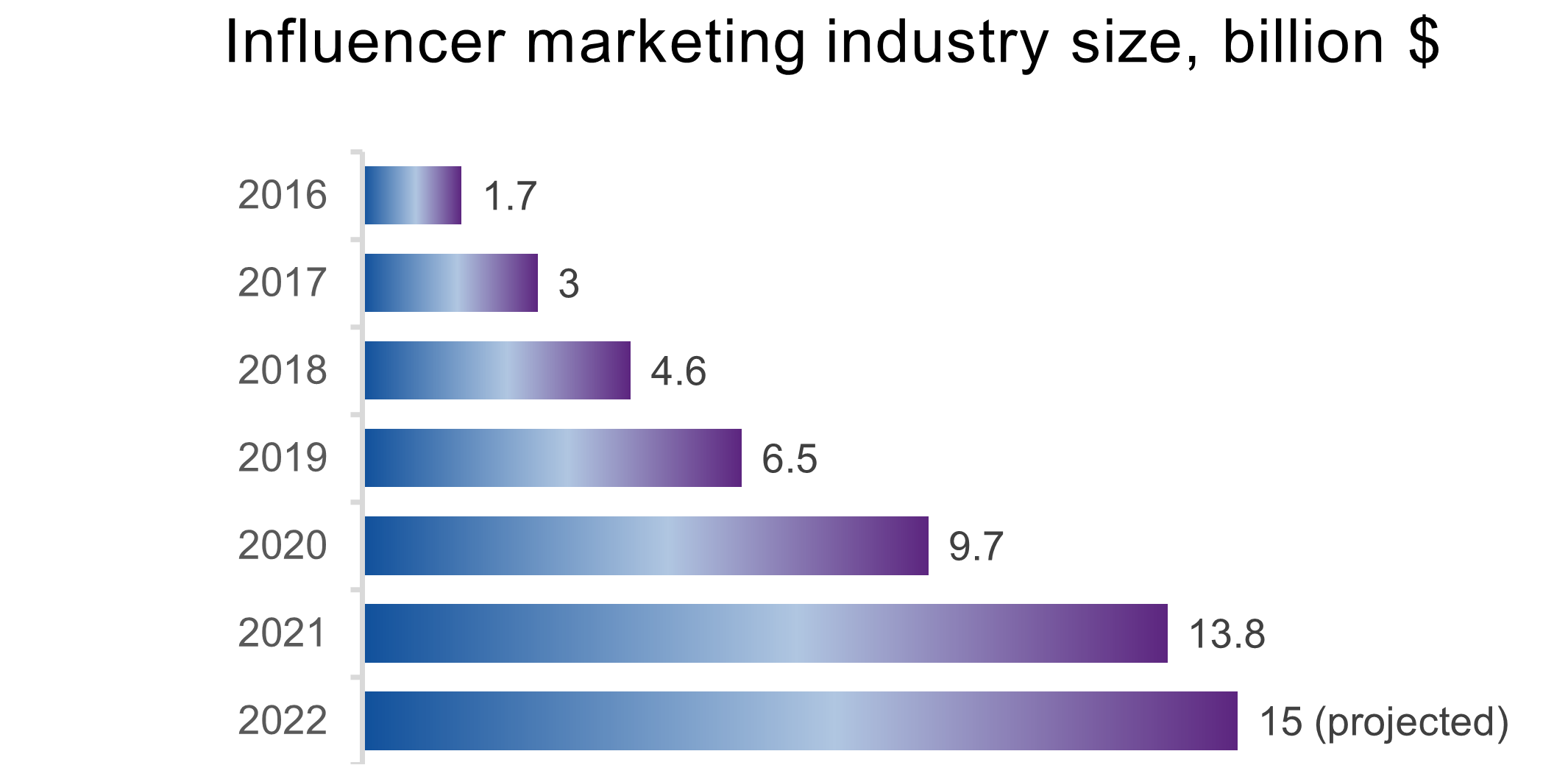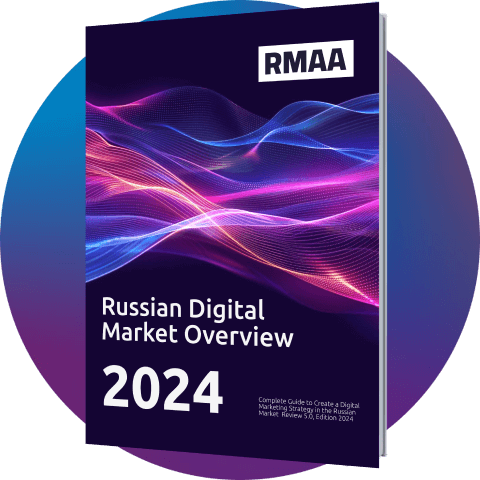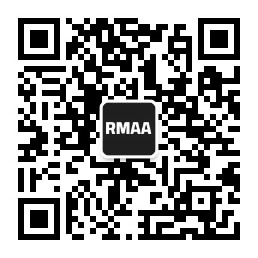Blog about successful marketing strategies in russia
Influencer Marketing in Russia. The Main Trends of 2022


DIGITAL MARKETING
Share this Post
Influencer marketing has long been widely recognized as one of the most successful promotion tools. According to Сollabstr , the size of the global influencer marketing has grown by 42% compared to the previous year ($ 13.8 billion), and by the end of 2022 it will be approximately $ 15 billion.

Source: Сollabstr, 2022 Influencer Marketing Report
This trend has been observed in Russia, where advertisers are increasingly choosing such a promotion tool using various platforms and social services. Experts of the Association for the Development of Interactive Advertising (ADIA) are confident that interest in influencer marketing in Russia has only been enhancing over the past years. Leading brands successfully integrate bloggers into commercial products, expand the presence of opinion leaders outside social networks and develop new approaches to communication with the audience.
Against this background, RMAA specialists, having extensive experience in work with influencers in Russia, decided to carry out their own market research based on general trends in marketing and regional specifics.
A Few Words About Effectiveness
One of the key features of influencer marketing is its flexibility. That is, while developing a particular product promotion strategy on the market, the advertiser does not have a clear plan for working with influencers. Everything will depend on many factors, including the integration channel, audience, budgets, published content, etc. This is an advantage and disadvantage of this tool at the same time.
On the one hand, you can choose an opinion leader and “get” to a potential audience that will “follow” him and think about the product. On the other hand, an improperly selected influencer can negatively affect the brand image and user opinions. The success of integrations will depend directly on whether the company's values coincide with the values of the opinion leader and his audience. Therefore, it will be ineffective to launch a campaign with influencers without analytical data. But “the game is worth the candle”, since the influencer's advertising, which is more often native brand integration, has a greater degree of audience confidence and causes positive responses.
Classification of Influencers on the Market - Who, Why and for What Advertising?
The most common mistake related to influence marketing is that many people incorrectly consider all influencers to be bloggers. In fact, bloggers are a separate niche. To figure this matter out, it shall be understood what types and what niches are occupied by influencers on the market.
On the Russian advertising market several classifications of influencers can be distinguished according to different parameters.
Number of subscribers:
Nano influencers (1K-10K subscribers) are considered to be very active subscribers on social networks and have high engagement rates, are in very close relationships with their followers. Therefore, integration with them will be fully successful at the stage of launching a campaign or a test strategy to promote the product to a new audience.
Micro influencers (10K-100K subscribers) - as well as nano, communicate quite closely with their subscribers and have an audience interested in the content. As a rule, such influencers specialize in a specific niche (beauty, travel, etc.), which makes it easier for advertisers to create successful integration.
Macro influencers (100K-1M subscribers) are usually Internet celebrities on various social resources. They can be bloggers, vloggers (video content) or podcasters (audio content). These influencers are constantly working to increase their audience, but mostly do not communicate with their subscribers on a more personal level. Therefore, the macro engagement coefficient will be less than that of the first two categories. But they will help the brand to expand the coverage of the campaign, attract a new audience and improve its reputation in general.
Mega influencers/celebrities (from 1M subscribers) - require a significant budget for cooperation and understanding that integration will have a very broad coverage. Working with celebrities will be successful if the company wants to draw attention of representatives of various audience segments to its product within a relatively short period.
Niche bloggers:
Gamers - go live on platforms such as Twitch and Youtube, gathering millions of users. Despite the fact that such influencers often promote video games and everything related to them, their target audience is quite diverse. Therefore, integrations with gamers will be successful for brands from other categories (clothing, shoes, drinks, etc.). Gamers' content is divided into game reviews, tips, challenges, videos, team tournaments, and also depends on the type of game (action, strategy, etc.).
Sports leaders are interesting to users due to the motivational content. As a rule, such influencers support everything related to the health industry: sports brands, food and beverages, nutrition programs, sports complexes /fitness studios and much more. They can “promote” yoga, running, CrossFit, weight loss, etc. Depending on the niche, the audience will be different in gender, age and other indicators.
Bloggers and vloggers are currently the most popular type of influencers. They often have a huge number of subscribers (mega- and macro-) within their author blogs or Youtube channels. They are divided into reviewers (they tell and share their opinions on certain topics depending on niche) , prankers (arranging practical jokes) and show hosts (experts using Youtube as a platform for posting content). Bloggers and vloggers are distinguished by high-quality content that makes them authorities in their niches. Therefore, such types of influencers can help to increase brand awareness, sales and site traffic, as a minimum.
Photographers - as a rule, are attracted by well-known companies to promote photo equipment and other accessories. What is more, the number of subscribers of such influencers may be different. In this case, advertisers look at the content - the brighter it is, the more likely it is to integrate with the account owner.
Travel bloggers are distinguished by different types of content, including a mix of travel tips, routes with reviews of travel brands. Therefore, integration with such an opinion leader can be used to promote various niches (fitness, places to visit, etc.).
Beauty bloggers are one more of the most popular types of influencers, as about 43% of consumers follow influential people in the beauty industry. Beauty bloggers use different reviews of products/brands, tips on how to use and much more to promote their content on various platforms (Instagram*, Telegram, Youtube, etc.). Therefore, they can easily increase sales and awareness of a particular cosmetic brand as a whole. At the same time, opinion leaders from this category can be very different - from ordinary women who use cosmetics every day to professional makeup artists and celebrities.
Fashion bloggers are influential people who specialize in clothing, jewelry and watches, shoes, accessories, etc. It gives them a large number of advertising integrations to promote various products. As a rule, fashion bloggers work with fashion brands directly, use the content that includes video reviews with shopping trips, as well as style tips.
Parents publish content about everything related to this topic. Therefore, they often carry out product reviews and share tips. Along with that, they can promote products in a very wide range of industries.
Status in relation to the brand:
Ambassador is an opinion leader who will officially present a brand in order to increase product awareness and promote sales growth. Cooperation implies a high degree of loyalty of the influencer to the brand and a deep understanding of the products. Ambassadors can be external (invited celebrities) and internal (employees and management of the company). Both categories are in demand among advertisers because they have high efficiency.
Advocates are experts whose opinion is listened to in certain matters. They are usually loyal customers of the brand and companies often use such influencers to overcome crisis situations.
Evangelists are loyal users who recommend the company's products to their friends. Recently, the trend to invite evangelicals to integration has been gaining popularity among marketers, since their advertising has a higher level of trust and engagement, and also allows them to find a new audience.
The selection of influencers from different groups is based on the specific objectives of the campaign. At the same time, leading marketing experts notice some general trends in 2022, affecting mainly the Russian market. Thus, the Association for the Development of Interactive Advertising (ADIA) has published a report with regard to this issue, based on the opinions of various experts.
Key Trends of Influencer Marketing in Russia 2022
First of all, many experts are confident that successful future of dealing with influencers lies with competent analytics. This applies to such aspects as establishment of mechanisms for procurement of advertising from opinion leaders, measurement of activation results to evaluate KPIs and campaign results, analysis of profiles and identification of various factors (added and got fast subscribers, reactions and activity), etc. And, if earlier advertisers had enough integration reports in the form of screenshots of publications, now specialists have started to pay more attention to analytics.
Secondly, some opinion leaders actively use non-advertising ways of earning money. In this way, influencers monetize their work through donations from subscribers, paid content, their own merch, as well as partner income from the live stream sales of goods. Among other things, in 2022, Russia expects the monetization of blogger services through NFT, which is already successfully integrated in other countries. This will allow opinion leaders to promote not only published content, but also digital assets.
Thirdly, advertisers are more frequently thinking about other integration strategies - not in content, but in bloggers' own online products. At the same time, they are considering long-term cooperation with influencers. Since the abundance of advertising of various products from one opinion leader (which was previously considered the norm) is beginning to push the audience away from brands more and more. And also, they use opinion leaders in other brand channels. In other words, influencers are beginning to be used not only for the purpose of publications on social networking sites, but also for other advertising formats.
And of course, the market is constantly required new faces. In particular, we are talking about the younger generation Alpha, actively using social media and other Internet resources. Many experts are sure that representatives of this audience are more and more relying on opinion leaders.
"The simple authenticity that influencers offer is very attractive to the generation Alpha. Why do you need to analyze information from multiple sources if you can listen to a blogger you trust? In this connection, it is worth raising the issue of social responsibility of bloggers. Great popularity and influence impose certain obligations on them to the younger generation, so it is important for brands to think about ethical cooperation with influencers," —Anton Petukhov, Chairman of the IAB Russia Influencer Marketing Committee, co-founder of Woombat.
Microfluencers - the Future That Has Become the Effective Present
Starting from the end of 2020, many analytical services, marketing agencies and other market participants began to talk about the high efficiency of microfluencers in promoting products on the market. And they turned out to be right.
Analysts of the Klear service were among the first who noticed this at the end of 2018, assessing the quantity and quality of sponsored posts by micro-influencers around the world. According to their data, 84% of such posts on Instagram* received up to 1,000 likes per post.

Source: Klear’s State of Influencer Marketing Report 2019
Then, specialists from Expertvoice analyzed the efficiency of integrations from the point of view of the audience of bloggers. According to their calculations, 82% of consumers are ready to purchase goods or service upon the recommendation of a microfluencer, since they perceive such advertising as friendly advice.
Gradually, the theory turned into practice. And advertisers all over the world started talking that microfluencers are really effective. To the list of successful integrations, you can add the Amazon Influencer Program, the L'Occitane internal corporate campaign, as well as effective cases on the Russian market. For example, we should mention Sberbank cooperation with influencers (through the Perfluence service) within the SberMarket platform. Since 2019, this advertising campaign provides an increase of 30% in new customers.
As a result, by 2022, cooperation with micro-influencers has become the norm for many companies. Besides, these integrations allowed some of them to hold the audience attention during the blocking of the leading social resources in Russia (Instagram*, Tik Tok, etc.).
According to the aforementioned Perfluence, the demand for micro-influencers' advertising publications in blocked social networks increased by 30% in the second quarter of 2022. More than 300 thousand bloggers from all over Russia took part in the survey, and about 200 thousand publications posted in the period from March 7 to April 25, 2022 were analyzed. It turned out that 60% of advertising integrations were made by bloggers with an audience of up to 50 thousand subscribers and 90% of advertisers were Russian companies. Also, the number of advertising contracts for influencers with more than 200 thousand subscribers decreased by 50%.
Experts believe that the main reason for the growth of microbloggers' earnings and effectiveness of advertising integrations is the appearance of new brands on the market that need active promotion. And since a significant percentage of the audience still continues to use blocked social networking websites via VPN, many advertisers are reluctant to refuse these channels. If before the brands were dealing with major bloggers, as a rule, now such integrations are ineffective due to the low degree of audience engagement of the aforementioned influencers. In addition, some of the opinion leaders “leave” for domestic resources (VKontakte, Odnoklassniki, etc.). However, according to various experts, only 20-30% of their subscribers tend to follow their favorite blogger. Therefore, the “bet” is placed on micro-influencers who have a large percentage of subscribers involved and require a low cost for integration from the advertiser.
In other words, during the period of uncertain social activity of the audience, campaigns with micro-influencers in 2022 can be considered a kind of “lifesaver” for new brands in Russia. And also, they are helpful for those companies that have not yet had time to change the usual tools for promotion.
As practice shows, dealing with influencers, regardless of their category, will be successful if you approach this issue with maximum analytical information, a clear understanding of why you need to use an opinion leader, what goals he should fulfill and on what resources.
Entrust this task to RMAA experts who are ready to find the right opinion leaders for your products, depending on the purposes and objectives of promotion on the Russian market.
Join 2,000+
of your Peers!
You will be the first to know about Russian marketing insights, news and updates from our agency. Stay tuned!
Get our latest articles delivered to your email inbox and get our exclusive White Paper
"Digital Marketing in Russia. Finding your customers on the internet"
for FREE!
Russian Digital Market Overview
Strategic Insights into Russian Digital Marketing Landscape

Ready to partner with the specialists in Russian marketing and advertising?
About the Author
A content lead. Natalia runs marketing projects promotion with different digital tools in the Russian-speaking market.
Join 2,000+ of your Peers!
Get our latest articles delivered to your email inbox and get our exclusive White Paper "Digital Marketing in Russia. Finding your customers on the internet" for FREE!
You will be the first to know about Russian marketing insights,
news and updates from our agency.
Stay tuned!
We're updating our website's design step by step, so some pages may look different. Thank you for your understanding.
Got it














